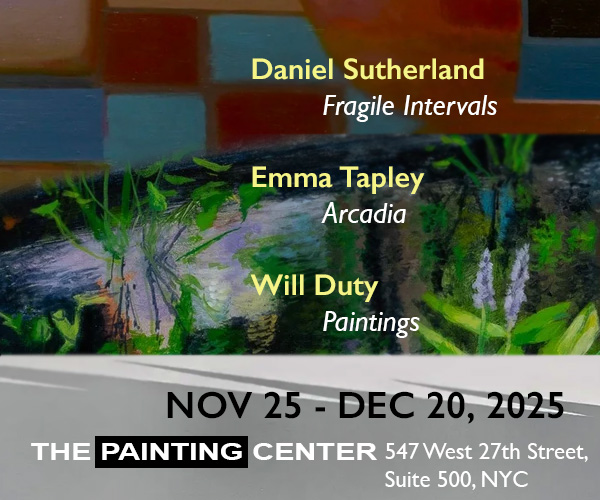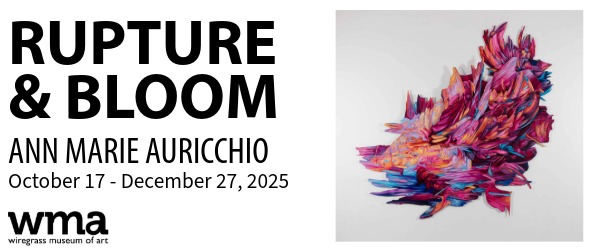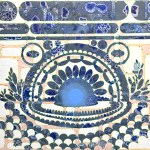
Contributed by Adam Simon / The space between 0 and 1 is infinite. I thought of this in relation to David Diao�s exhibition, “Studios and Sales,” currently at Postmasters. The show is an inspired pairing of two works, Studios, Updated and Sales. Sales is an arrangement of twenty-five smallish paintings from 1992 that documents Diao�s painting sales between 1968 and 1992. Studios, Updated diagrams all of the spaces Diao has lived and worked in since arriving in New York in 1964. What the paintings purport to give us is catalogued data, the purview of an archivist or an estate manager. At first glance, not much distinguishes the work from the kind of information display that it evokes. Somehow Diao manages to present statistical information in what appears to be a straightforward manner and have it result in paintings that I find profound. This is what made me think of the space between 0 and 1.
“The starting point of my work has been a certain devotion to the lineage of abstraction as developed in high modernism. But unlike the formalist use of abstraction, I employ these forms to the specific tasks of troubling the history of modernism itself, and also my own personal history of over forty years as an artist.”� –David Diao, 2014

Much has already been written about Diao�s �troubling the history of modernism,� specifically his challenge to Greenbergian formalism and its injunction against anything that strays from the purely visual. It might be time to consider Diao�s paintings as paintings, to consider how they actually function for a viewer.
Writing about Diao�s paintings is complicated, however. His work is full of mixed messages, contradictions, sleights of hand, and deceptive appearances. It can appear emotionally detached, or seem primarily a vehicle for a critique of modernism. It�s not that these ways of understanding the work are wrong or false. It�s just that any reductive reading will undermine the inherent richness of the experience offered. One misconception is that the content of the works is the information presented, that the paintings are �about� information. If the paintings are about anything, they are about an interaction between a viewer and an object viewed. Another misreading might be that Diao uses the minimalist field of seemingly flat color merely as a trope that can double as backdrop, as d�cor for whatever image or information is placed on it. This interpretation doesn�t mesh with his particular touch. It doesn�t explain the delicacy with which he applies the paint, or why his combinations of colors can be so moving. The viewer is left to puzzle out the relationship between the information conveyed and the experience of being in the presence of the work.

Sales has only been exhibited once before, in 1992 (the year it was made), at the Ecole des Beaux Arts in Dijon, France. After that, the project sat in boxes in Diao�s studio. Studios is a recently updated painting begun in 1991. Both works combine thinly applied acrylic paint with vinyl appliqu�. The appliqu� consists of text and chronological dates, and also, in Sales, oversized versions of the red dots one might see on a gallery exhibition list. Seen together, the two works might seem like Diao�s contribution to the genre of self-portraiture. But late Rembrandts, for example, tempt the viewer to read the artist�s returned gaze as both a critical self-assessment and a summing up. The Diaos resist this kind of psychologizing. They are not so much a portrait of the artist as they are one of any artist who has to struggle to sell paintings and maintain a studio in which to make them.
It�s possible to apprehend Sales as something like a musical score composed of three elements, two of which, the ground and white numbers, remain constant, and one, the red dots, vary in number and therefore in intensity, appearing and disappearing. Subsequently, one discovers that each of the numbers represents a year, that the ground is not uniform but composed of swirls of modulated darker and lighter color, and that each of the red dots stands in for a painting sold during that year. Only then does interpretation enter in; that even an artist of Diao�s stature is subject to a fickle art market, that flush years are followed by lean ones, that the upward trajectory is as elusive for most artists as it is for restaurants or any other business dependent on the herd instinct.
My first impression of the single painting Studios, Updated was that the colors were beautiful and not attributable to anything as utilitarian as the red dots representing sales in Sales. A column of vertically-spaced lavender blocks interrupts a pastel green ground. The blocks represent the floor plans of the artist�s studios and living spaces. Each of the floor plans has a corresponding block of black vinyl text in a second column. At the top left of the painting is white hand-written text at a slightly oblique angle, providing scale. As in the ground in Sales, the green is not uniform but rather covers a white underlayer that bleeds through intermittently. The green asserts equal pressure over the entire surface, coexisting with the columns of the floor plans and text without ever becoming background.
Even without square footage, some of these floor plans look spacious and it�s hard not to think about the dire lack of affordable space for artists now. Contemplating the painting in this way, though, would focus on information conveyed by the work and ignore the cumulative effect of color, surface, allusions to past painters, and the way the extreme frontality of the painting reinforces its almost human presence. Diao may allow for this kind of tone-deaf reading of his work by giving us the bare minimum of affect. He eschews the subjective mark-making that makes the artist a presence in a painting. If the information is seen as primary it is because it challenges the idea that painting should be purely visual � that is, divorced from a critical understanding of the world we live in. Ironically, Diao�s argument with formalism is persuasive, because of the way he paints.
“David Diao, Studios and Sales,” Postmasters, 54 Franklin Street
New York, NY. Through January 25, 2019. Also on view: “Jennifer and Kevin McCoy: CLEANER“
About the author: Artist Adam Simon is affiliated with Studio 10 in Bushwick. His most recent solo show, �From this Position,� took place earlier this year.
——-
NOTE: We are in the middle of the 2019 Two Coats of Paint year-end fundraising campaign. This year we�re requesting funding to continue our work supporting artists and arts organizations through 2020. You might think of your contribution as an annual subscription. We hope to generate enough revenue to offset rising costs for web hosting, design, the newsletter, and editorial help, and also to compensate our contributors for more fine pieces. If you value what we do at Two Coats of Paint, please consider supporting us for another year. New limited-edition canvas tote bags are being screen-printed and will be given to the first 100 readers to contribute $150 or more. Thanks in advance for your generous tax-deductible contributions �> Please click here to contribute.
——
Related posts:
Stopping time: On Kawara and Danica Phelps
On Kawara: Carpe Diem
Rita Ackermann�s Texas diary
The materiality of written language






















